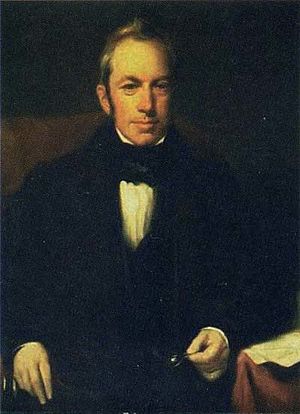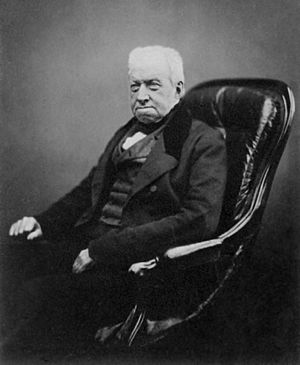Robert Brown (botanist, born 1773) facts for kids
Quick facts for kids
Robert Brown
|
|
|---|---|

Portrait by Henry William Pickersgill
|
|
| Born | 21 December 1773 Montrose, Scotland
|
| Died | 10 June 1858 (aged 84) London, England
|
| Nationality | Scottish |
| Citizenship | British |
| Alma mater | University of Aberdeen University of Edinburgh |
| Known for | Brownian motion |
| Scientific career | |
| Fields | Botany |
| Author abbrev. (botany) | R.Br. |
Robert Brown (born December 21, 1773 – died June 10, 1858) was a Scottish botanist. He studied plants, both living ones and ancient plant fossils. Brown made many important discoveries in botany, especially by using a microscope.
He was one of the first to describe the cell nucleus in detail. He also observed cytoplasmic streaming, which is the movement of fluid inside plant cells. Brown is most famous for discovering Brownian motion. He also studied how plants are pollinated and fertilized. He was the first to see the main differences between gymnosperms (plants with "naked" seeds, like conifers) and angiosperms (flowering plants with seeds inside fruits). His work also included early studies of palynology, which is the study of pollen. Brown also named many plant families, genera, and species, especially from Australia.
Contents
Early Life and Love for Plants
Robert Brown was born in Montrose, Scotland, on December 21, 1773. His father, James Brown, was a minister. Robert went to the local Grammar School and then to Marischal College in Aberdeen. In 1790, his family moved to Edinburgh.
He started studying medicine at the University of Edinburgh. But he became much more interested in botany, the study of plants. He spent most of his time on botany instead of medicine. Brown went on trips into the Scottish Highlands to find and study plants. He wrote very careful descriptions of all the plants he collected. He also started sharing his plant findings with other famous botanists.
During this time, Brown discovered a new type of grass called Alopecurus alpinus. He also wrote his first paper about plants, "The botanical history of Angus." He read this paper to a natural history group in 1792.
In 1793, Brown stopped his medical studies. In 1794, he joined the army as a Surgeon's Mate. His army duties were light, so he had a lot of free time. He used almost all of this time to study plants. He was especially interested in cryptogams, which are plants that reproduce using spores, like mosses and ferns.
By 1800, Brown was well-known among plant scientists in Ireland. He was talking with many botanists in Britain and other countries. He had even been suggested to join the Linnean Society of London, a famous group for naturalists. He also started using a microscope to study tiny plant parts.
Journey to Australia on the Investigator
In 1798, Brown heard about a chance to join an expedition to New Holland (now Australia). There was an open spot for a naturalist. A friend suggested Brown to Sir Joseph Banks, a very important scientist. Banks was told that Brown was a "professed naturalist" and a "Scotchman, fit to pursue an object with constancy and cold mind."
Brown was not chosen for that trip. But in 1800, Matthew Flinders proposed a new expedition. This trip would explore the coast of New Holland to see if it was one large island or several. Sir Joseph Banks approved Flinders' plan. In December 1800, Banks offered Brown the job of naturalist for this new expedition. Brown accepted right away!
Preparing for the Voyage
Brown expected to sail very soon after being offered the job. But there were many delays, and the ship didn't leave until July 1801. Brown used this time to get ready. He studied Australian plant specimens that Banks already had. He copied notes and descriptions to use during his own journey.
Brown's main job was to collect scientific specimens of all kinds. But he was told to focus most on plants, insects, and birds. Other studies, like geology, were less important. The scientific team included Ferdinand Bauer, a talented artist who drew plants, and Peter Good, a gardener who collected live plants and seeds for Kew Gardens. Brown was in charge of Bauer and Good.
Stops Along the Way
The ship, called Investigator, left London on July 18, 1801. They made short stops at the Desertas Islands and Madeira. Brown didn't find much new there. They arrived at the Cape of Good Hope (in South Africa) on October 16. They stayed for over two weeks. Brown explored a lot and climbed Table Mountain at least twice. He later said that some of his "pleasantest botanizing" was on Devil's Mountain near Cape Town.
Exploring Australia
The Investigator reached King George Sound in what is now Western Australia in December 1801. For three and a half years, Robert Brown did intense plant research in Australia. He collected about 3,400 different types of plants. About 2,000 of these had never been known before!
Sadly, a large part of his collection was lost. This happened when another ship, the Porpoise, sank on its way back to England.
Brown stayed in Australia until May 1805. Then he returned to Britain. He spent the next five years studying all the plants he had collected. He wrote descriptions of many new species. In Western Australia alone, he described almost 1,200 new species. He also named many important Australian plant groups, including Livistona, Dryandra, Grevillea, and Telopea.
Later Discoveries and Career
In 1810, Brown published his famous book, Prodromus Florae Novae Hollandiae et Insulae Van Diemen. This was the first detailed book about the plants of Australia. It described many new plants, including over half of New Zealand's orchid groups.
That same year, he became the librarian for Sir Joseph Banks. When Banks died in 1820, Brown inherited his huge library and herbarium (a collection of dried plant specimens). In 1827, this collection was moved to the British Museum. Brown became the first Keeper of the Banksian Botanical Collection there.
In 1831, Brown gave a paper to the Linnean Society. In this paper, he named the cell nucleus. Other scientists had seen the nucleus before, but Brown was the one who gave it the name we still use today. He also gave credit to Franz Bauer, who had drawn it in plant cells in 1802.
After the British Museum's Natural History Department was divided in 1837, Robert Brown became the first Keeper of the Botanical Department. He held this job until he died. He also served as President of the Linnean Society of London from 1849 to 1853.
Robert Brown passed away in London on June 10, 1858. He was buried in Kensal Green Cemetery.
Brown's name is remembered in many ways. A type of Australian herb called Brunonia is named after him. Many Australian plant species also carry his name, like Eucalyptus brownii and Banksia brownii. A moss he discovered in Scotland is called Brown's Tetrodontium Moss (Tetrodontium brownianum). In Tasmania, a river called Brown's River is named for him. In South Australia, Mount Brown and Point Brown were named by Flinders during the Investigator expedition. Mount Brown in Canada is also named after him.
Brownian Motion
In 1827, Robert Brown was looking at tiny grains of pollen from a plant called Clarkia pulchella under his microscope. The pollen was floating in water. He noticed that tiny particles, which we now know are parts of the pollen, were moving in a continuous, shaky way. This movement was random and jerky.
To see if this movement was related to living things, he then looked at tiny particles of non-living matter, like dust, in water. He saw the same shaky motion! This showed that the movement was not just because the pollen was alive.
Even though Brown didn't have a theory to explain this motion, the phenomenon is now known as Brownian motion. It's a very important concept in science, helping us understand how tiny particles move due to collisions with even smaller, invisible molecules.
For a while, some people wondered if Brown's microscopes were good enough to see such tiny movements. But in 1991, a British microscopist named Brian J. Ford showed that Brown's original microscope was indeed powerful enough. He even made a video showing the same observations Brown made. This proved that Brown's discoveries were correct.
See also
 In Spanish: Robert Brown para niños
In Spanish: Robert Brown para niños



